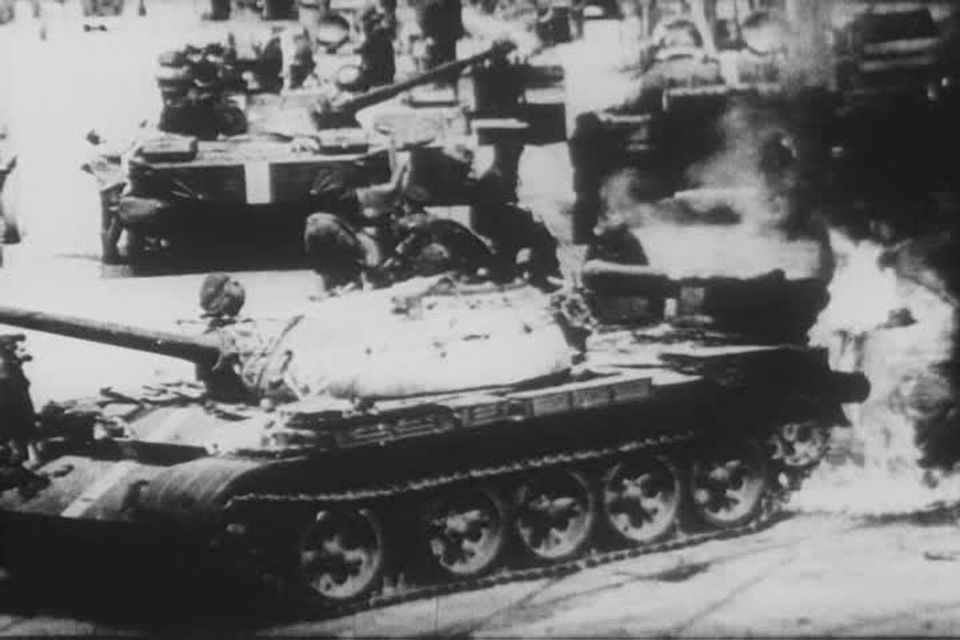By CLARA WEISS
 Soviet tanks in Czechoslovakia in 1968
Soviet tanks in Czechoslovakia in 1968
Fifty years ago, o n the night of August 20-21, 1968, some 165,000 soldiers and 4,600 tanks from four Warsaw Pact states—the Soviet Union, Poland, Hungary and Bulgaria—accompanied by military advisors from East Germany invaded Czechoslovakia.
Establishment of a deformed workers’ state in Czechoslovakia
The invasion and occupation of Czechoslovakia sent shock waves throughout the world. Aimed at suppressing a growing popular movement of workers and youth during the so-called “Prague Spring,” it discredited the Stalinist regimes, which were falsely equated with socialism, in the eyes of millions around the world.
Along with the mass general strike in France a few months earlier, the invasion of Czechoslovakia was a defining event of that period. It set into motion political and social developments that were to shape this part of the world for decades to come.
This series will review the origins of the crisis of 1968, its dynamic, and the role that Pabloism played in enabling the Stalinist bureaucracy to oppress working class opposition to its rule.
Czechoslovakia was one of a series of deformed workers’ states established in 1948 in Eastern and Southeastern Europe. The country had been partitioned in 1938 in the infamous “Munich agreement,” which the imperialist powers agreed to after Hitler’s invasion of northwestern Czechoslovakia and annexation of the so-called “Sudetenland.” Most of what is now the Czech Republic was annexed to the Nazi Reich. The so-called “Slovak Republic” was ruled by a far-right bourgeois regime that joined the Nazi effort to exterminate the Jewish population and wage a war of annihilation against the Soviet Union.
By the time the Red Army liberated Czechoslovakia in 1945, the country had lost about 3.7 percent of its total population in the war. This was considerably less than in neighboring Poland or the Soviet Union, but it was significantly greater than in most Western European countries that had been occupied by the Nazis.
Of the pre-war Jewish community of about 255,000 people, only between 40,000 and 50,000 survived. Over 90 percent of the 8,000 Sinti and Roma who had lived in the Czech lands were murdered. In the most infamous act of terror by the Nazi regime in Czechoslovakia, the SS torched the entire village of Lidice following the assassination of SS leader Reinhard Heydrich by members of the Czechoslovak resistance movement. Hundreds of people, including many children, were murdered or put into concentration camps.
An estimated 25,000 Czechoslovak communists who resisted the fascists were murdered. Tens of thousands of workers were forced into slave labor by the Nazi regime. Many more were wounded or displaced. The total material losses from the war were estimated at $4 billion.
In contrast to many other Eastern European countries, where the working class was decimated by the Nazis’ brutal war of annihilation, Czechoslovakia, whose economy in both the Czech lands and Slovakia had been put almost entirely at the disposal of the Nazi war economy, experienced considerable industrial growth during the war. By 1945, the industrial working class was more numerous than ever before.
Meanwhile, the Munich betrayal of 1938 and the war had totally discredited both capitalism and bourgeois democracy. As historian Kevin McDermott has noted, “…there was a widespread belief that right-wing parties and their ‘bourgeois’ leaders had collaborated with the Germans under the occupation.” [1] In short, anti-capitalist and pro-Soviet sentiment was overwhelming.
World Socialist Web Site for more
